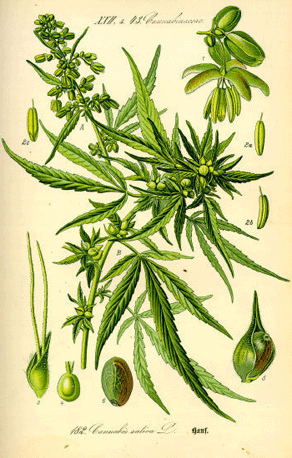
Webshaykh’s note: In the process of researching the medical aspects of the chewing of qât (Catha edulis) leaves in Yemen, I consulted an important study published almost forty years by the distinguished historian Orientalist (in the best sense — and there is a best sense — of the word) Franz Rosenthal. This was his The Herb: Hashish versus Medieval Muslim Society (Leiden: Brill, 1971). Appearing at a time when hashish had become a household word in America, Rosenthal sorts through legal, medical and literary sources to provide a historical overview of the issues surrounding the use of hashish, the plant known as qinnab in Arabic (Cannabis sp). This is a valuable resource, but also worth a good read to get a sense of how an addictive socially popular drug was viewed for almost the last full millennium. Fortunately for those of us who cannot afford massive libraries, this book is available as a Google Book online. I quote from the conclusion.]
Hashish, the Individual, and Society
In conclusion we must state again that our knowledge is very limited. The gaps are tremendous. The nature of the information we do have is not easily assessed. Its applicability to the realities prevailing over the immense extension in time and space of medieval Islam is often suspect. Partisanship pro or con, coupled with a seemingly widespread ignorance of hard facts, obscures everything. Statistics naturally are non-existent.
Our sources give the impression of a westward march of hashish that had its serious beginnings int he twelfth century and gathered speed during the thirteenth century. A certain confirmation of these dates may be found in the further impression that voices seemingly in favor of hashish would appear to belong largely to the earlier stages of literary attestation. This would indicate that at first a restricted use of the drug presumably by Sûfis made it possible to view it as something affecting individuals rather than society and therefore limited in the harm that it was considered to be able to cause. Soon, however, the alert went out. Hashish was branded as a danger to society. The voices raised against it were at first strong and insistent. When Ibn ‘Abd-az-Zâhir wrote a sort of official paper against it, he implied that first it was wine that had to be fought against, but now, he stated, hashish had become a fashion and therefor a social danger. Human resistance began to assert itself, and the broad assumptions that governed the edifice of Islam as a religious and legal structure were put to the test. It cannot be said that they were found wanting, but they did provide the aggressive and irresistible strength that would have been necessary. Jurists clung to the lifeline thrown to them by the prohibition of wine. In theory it seemed very strong but had itself worn thin in stretches by custom and abuse. Thus they were unable to provide much support for the strict prohibition of hashish which most of them seem to have thought necessary.
The addicts, on their part, felt that they could be at peace with their Muslim conscience. Where pure hedonism was not a sufficient excuse for indulgence, the drug could also be claimed to open up new spiritual and intellectual vistas and thus to contribute to an otherwise unobtainable sharpening of the religious experience, thereby bringing mankind closer to what was imagined to be its essential goal.
The spread of hashish was facilitated by its easy accessibility. This recommended it to the urban masses. The by and large asocial character of hashish use was a welcome help in fighting the frustration of daily life, again something particularly desirable in an urban environment. The social stigma and loss of respectability associated with hashish were, it seems, no real deterrents, all the less so since the use of it was easily concealed…
Whatever one may think of the uncompromising and harsh attitude of Ibn Taymîyah, he must be given credit for having recognized the societal aspect of hashish addiction and to have stated it clearly and succinctly in so many words, and not only by indirection. Given their outlook as determined by Islam and their limited factual knowledge, thoughtful Muslims will have understood and shared his view. “Hashish,” Ibn Taymîyah says, “requires the hadd penalty more than wine. The harm a hashish eater causes to his own person is greater than that caused by wine. On the other hand, the harm a windedrinker causes to the people is greater (in view of the quarrels and the like provoked by alcohol). However, in these times, because the consumption of hashish is spreading, the harm coming from it to the people is greater than than of wine.” “The people” here is another word for our “society.” Hashish had become a threat to it, and the fight was on. Effective countermeasures were not readily available, once mere repression proved futile, until, perhaps, as among the later Wahhabites, it was accompanied by an entirely changed orientation. The conflict between what was felt to be right and morally and socially good and what human nature craved in its search for play and diversion went on.
Excerpt from Franz Rosenthal, The Herb: Hashish versus Medieval Muslim Society (Leiden: Brill, 1971), pp. 159-161.